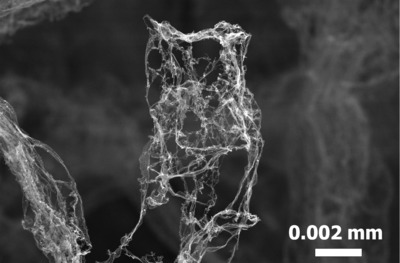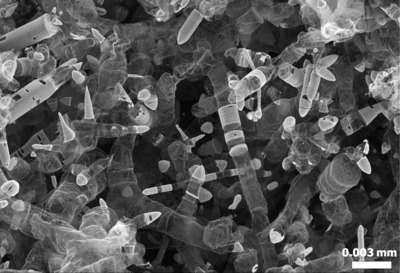Aerographite - a conductor as light as air
A network of porous carbon tubes that is three-dimensionally interwoven at nano and micro level is the lightest material in the world. It weighs only 0.2 milligrams per cubic centimetre and is therefore 75 times lighter than styrofoam, but it is very strong nevertheless. Scientists of Kiel University (KU) and Hamburg University of Technology (TUHH) have named their joint creation Aerographite.

The properties
It is jet-black, remains stable, is electrically conductive, ductile and non-transparent. With these unique properties and its very low density, Aerographite clearly outperforms all similar materials. It weighs four times less than the nickel material which previously held the record as the lightest material in the world. Not only does nickel have a higher atomic mass than carbon, but the scientists were able to produce a tube structure with porous walls that makes Aerographite so much lighter.
Despite its low weight, Aerographite is highly resilient. While lightweight materials normally withstand compression but not tension, Aerographite features both: an excellent compression and tension load. It is able to be compressed up to 95% and be pulled back to its original form without any damage. Up to a certain point it becomes even more solid and therefore stronger. Other materials become weaker and less stable when exposed to such stress. The new material absorbs light rays almost completely, giving it the claim to be the blackest black.
The construction
Simply explained, Aerographite is constructed like an ivy-web, which winds itself around a tree. The ‘tree’ is a so-called sacrificial template, as this is discarded after the construction process. The team of scientists use a zinc oxide in powder form, which they heat up to 900°C. This transforms the zinc oxide into a crystalline form which is made into a pill. The zinc-oxide pill forms micro and nano structures, so-called tetrapods. These interweave and construct a stable entity of particles that form the porous pill. In that way, the tetrapods produce the network that is the basis for Aerographite.

In a next step, the pill is positioned into the reactor and heated up to 760°C for chemical vapour deposition. A carbon-enriched streaming gas atmosphere deposits a graphite coating of only a few atomic layers thick onto the zinc oxide crystalline formation. This forms the tangled-web structures of the Aerographite. Simultaneously, hydrogen is introduced which reacts with the oxygen in the zinc oxide and results in the emission of steam and zinc gas. The remains are the characteristic interwoven, tube-like carbon structure of Aerographite.

The faster the scientists can remove the zinc, the more porous the tube’s walls get and the lighter the material is. This creates considerable scope for the team to be able to affect the characteristics of the Aerographite. They are constantly adjusting the template form and the separation process to explore different possibilities.
The application
Due to its unique material characteristics, Aerographite could be used as the electrodes of Li-ion batteries. This would reduce the amount of battery electrolyte used and would lead to an important reduction in the battery’s weight. This purpose has been strongly promoted and supported by those involved in this research. Areas of application for these small batteries might be electric cars or e-bikes. This material could make a great advance in the development of green means of transportation.
According to the scientists, further areas of application could be the electrical conductivity of synthetic materials. Non-conductive plastic could be transformed, without causing it to gain weight. Statics, which occur to most people daily, could hence be avoided.
The number of further possible areas of application for the lightest material in the world is limitless. After officially acknowledging Aerographite, scientists of various research areas were bursting with ideas. One likely use would be in electronics for aviation and satellites because they have to endure high amounts of vibration. The material has a lot of potential in aiding both air and water purification. It would act as an absorbent for persistent pollutants, which it would oxidise or decompose.
In particular, scientists would benefit from the combinations of mechanical stability, electronic conductivity and a large surface area of Aerographite.
Light reshapes semiconductors for advanced optical devices
Researchers have shown how light reshapes Janus semiconductors at the atomic scale, enabling...
Novel method to grow ultrathin semiconductors on electronics
Researchers have developed a technique that could speed up the development of next-generation...
Blue LEDs developed to enhance display performance
Researchers have developed a new method for manufacturing light-emitting diodes (LEDs) that emit...





